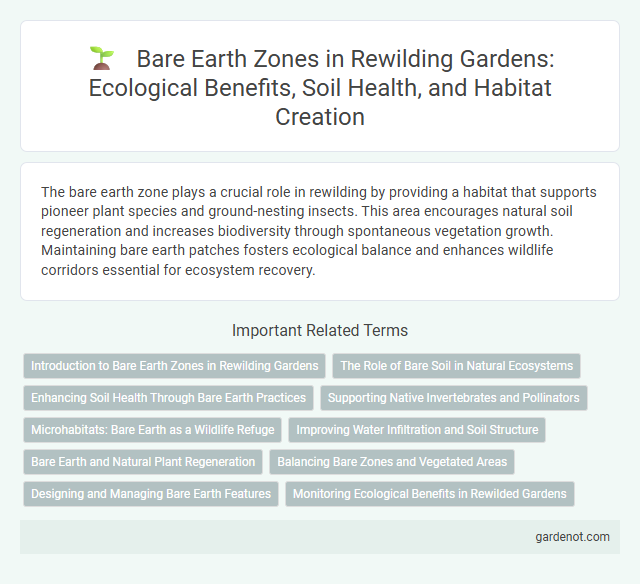The bare earth zone plays a crucial role in rewilding by providing a habitat that supports pioneer plant species and ground-nesting insects. This area encourages natural soil regeneration and increases biodiversity through spontaneous vegetation growth. Maintaining bare earth patches fosters ecological balance and enhances wildlife corridors essential for ecosystem recovery.
Introduction to Bare Earth Zones in Rewilding Gardens
Bare Earth Zones in rewilding gardens create essential habitats by removing human-made structures and invasive vegetation, allowing native flora to regenerate naturally. These zones promote biodiversity by providing open soil surfaces crucial for ground-nesting insects, seed dispersion, and microbial activity. Implementing bare earth areas enhances ecological succession and supports the re-establishment of native ecosystems within rewilding projects.
The Role of Bare Soil in Natural Ecosystems
Bare soil zones play a critical role in natural ecosystems by providing essential habitats for pioneer plant species and soil microorganisms that initiate ecological succession. These areas facilitate nutrient cycling and support biodiversity by enabling seed germination and creating microhabitats for invertebrates. The dynamic interactions within bare earth zones contribute to soil regeneration and ecosystem resilience, highlighting their significance in rewilding efforts.
Enhancing Soil Health Through Bare Earth Practices
Bare earth zones play a crucial role in enhancing soil health by promoting natural microbial activity and nutrient cycling. Exposing soil surfaces allows organic matter to decompose efficiently, fostering a rich habitat for beneficial microorganisms and earthworms critical to soil fertility. This practice improves soil structure, aeration, and moisture retention, ultimately supporting robust plant growth and ecosystem resilience in rewilding projects.
Supporting Native Invertebrates and Pollinators
The bare earth zone is essential in rewilding efforts by providing critical habitats for native invertebrates and pollinators, promoting biodiversity and ecosystem health. Exposed soil areas support ground-nesting bees, beetles, and other key species crucial for pollination and natural pest control. Maintaining these zones enhances pollinator populations, directly benefiting plant reproduction and ecosystem resilience.
Microhabitats: Bare Earth as a Wildlife Refuge
Bare earth zones create essential microhabitats that serve as vital refuges for diverse wildlife species, offering exposed soil patches preferred by ground-nesting birds, reptiles, and invertebrates. These areas support crucial ecological processes such as seed germination, insect foraging, and thermoregulation, enhancing biodiversity within rewilded landscapes. Incorporating bare earth microhabitats into conservation strategies promotes habitat heterogeneity and resilience in natural ecosystems.
Improving Water Infiltration and Soil Structure
The bare earth zone enhances water infiltration by reducing surface runoff and allowing rainwater to penetrate deeper into the soil profile. Improved soil structure results from increased organic matter decomposition and root penetration, boosting porosity and microbial activity. This recharge of groundwater reserves supports native vegetation growth and restores ecosystem resilience.
Bare Earth and Natural Plant Regeneration
Bare earth zones serve as critical habitats where natural plant regeneration thrives without human interference, promoting biodiversity and ecosystem resilience. These areas allow pioneer species to establish, facilitating soil stabilization and the gradual return of native vegetation. Monitoring bare earth dynamics supports effective rewilding strategies by enhancing habitat connectivity and ecological succession.
Balancing Bare Zones and Vegetated Areas
Balancing bare earth zones with vegetated areas is essential for promoting biodiversity and ecosystem resilience in rewilding projects. Bare zones provide critical habitats for ground-nesting species, insects, and early successional plants, while vegetated areas offer shelter, food sources, and soil stabilization. Maintaining this dynamic mosaic supports ecological processes, enhances species diversity, and facilitates natural regeneration.
Designing and Managing Bare Earth Features
Designing and managing bare earth zones involves creating open soil patches to promote biodiversity and support native flora and fauna. Effective bare earth features require careful consideration of soil texture, moisture retention, and disturbance frequency to mimic natural processes while preventing invasive species establishment. Regular monitoring and adaptive management ensure these zones maintain their ecological function as critical habitats within rewilding projects.
Monitoring Ecological Benefits in Rewilded Gardens
Bare earth zones in rewilded gardens serve as critical habitats for soil invertebrates, fostering biodiversity and enhancing ecosystem functions such as nutrient cycling and water retention. Monitoring these areas through regular soil health assessments and species inventory provides valuable data on the success of rewilding efforts in restoring natural processes. Continuous ecological monitoring supports adaptive management strategies that maximize the benefits of rewilding for urban wildlife and soil quality.
Bare earth zone Infographic

 gardenot.com
gardenot.com